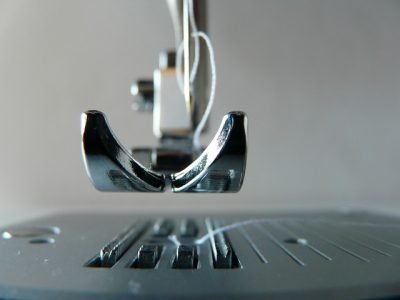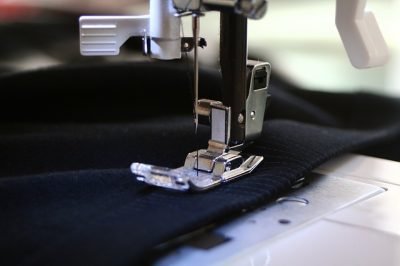 Whether you’re a newbie or an experienced sewing enthusiast, the machine you pick can make or break your enjoyment and commitment to the practice of sewing. A great machine will make picking up the sleights of hand you need to get those perfectly straight seams and flawless stitches effortless every single time, while the wrong one may very well make every session sat at the unit a chore, and go so far as to put you off sewing altogether.
Whether you’re a newbie or an experienced sewing enthusiast, the machine you pick can make or break your enjoyment and commitment to the practice of sewing. A great machine will make picking up the sleights of hand you need to get those perfectly straight seams and flawless stitches effortless every single time, while the wrong one may very well make every session sat at the unit a chore, and go so far as to put you off sewing altogether.
Since so much of the experience is reliant on the machine, we cannot stress enough on the importance of picking the right one. Made available by both retailers and independent dealers, who you go to in search of your perfect machine depends, to an extent, on you. If you have the budget for it, and are looking forward to committing yourself long-term to sewing together quilts, blankets, home décor accessories and so on, an independent dealership could give you the individual attention you’d likely need to find a machine that perfectly suits your needs. While more expensive, a first-timer could benefit from the personalized attention you’d receive from the dealer, which often includes classes and first-hand experience using the machine you’re considering buying so you can check the compatibility and whether or not handling it is your cup of tea. On the other hand, for the more experienced or those constrained by budget, an option available from a retailer could still give you the functionality and quality performance of a unit acquired from a dealer, as long as you know what you’re looking for.
To get you started on the quest for the perfect sewing machine, here are a couple of criteria to keep in mind.
Budget
If you’ve got a budget for your prospective sewing machine, our advice is simple – pick the most expensive unit you can afford. While cheaper and more budget-friendly units are available, these are oftentimes flimsy plastic contraptions more prone to malfunctioning than working correctly, and we’ve already covered how a frustrating sewing machine can put an end to your sewing aspirations altogether. While pricey doesn’t always equate brilliant, and you’ll have to be discerning about whether or not you think a sewing machine is going to deliver value for the money you pay, we’ll recommend steering away from the lower price brackets. While we understand the logic behind picking a cheaper machine, be it because you’re worried about your wallet, are merely dabbling with sewing to see if you’ll like it, or need it for a one-off project, it’s somewhat counter-intuitive if the machine you end up with does not deliver the degree of performance you’d need for satisfactory results. You don’t need the bells and whistles of hundreds of stitch and embroidery patterns – a solid unit covering the basics well can do you just as well, slotting safely into a reasonable budget bracket while still capable of handling fabrics from silk to canvas, sewing anything from dresses to leather jackets.
Stitch Types
Many units out there advertise hundreds of stitch patterns as a selling point of how great the machine is, but in reality a machine that sews straight and zigzag stitches are pretty much all you’ll need to get started with sewing. It’s fun to experiment with dozens of different stitch types, but for most projects, you’ll be perfectly covered by these two basic ones most standard machines equip you with.
Stitch Width and Length
This is where more flexibility is an attractive feature – machines that have wider ranges for stitch widths and lengths allow for more seamless, accurate and flawless stitching, giving you versatility in opting for tighter seams for fine fabrics like satin, and looser seams for thicker fabrics like denim, vinyl, leather, and corduroy. Adjustable stitch widths let you determine how open or closed your zigzag stitches will be, or how far each stitch goes from side to side. Examine your options and check out which machines offer the widest ranges for both these variables, and allow you to adjust them independently.
Presser feet
 We kid you not when we say there are hundreds of attachments to choose from, but a basic pressure foot lets you nail those straight and zigzag stitches we were talking about earlier. To enjoy more of the full potential of a good sewing machine, though, you’ll need additional attachments like an automatic buttonholer so you can sew buttons with accuracy and uniformity, without complicating the process stopping and turning your fabric and working a dial. Zipper feet are essential when you’re planning on sewing up items like quilt covers, pillowcases, dresses and more that would need a zipper attached, with minimum fuss and maximum efficiency. Depending on the types of projects you’re looking to undertake, there are plenty of presser feet attachments to make your machine that much more versatile – from blind hem feet to sew up indiscernible hems of curtains and dresses to a jeans foot for working with denim and heavier, thicker fabrics. Before starting off your search for the perfect machine, determine which types of attachments you’ll definitely be needing – at times sold with the unit or purchasable separately – for the projects you have planned.
We kid you not when we say there are hundreds of attachments to choose from, but a basic pressure foot lets you nail those straight and zigzag stitches we were talking about earlier. To enjoy more of the full potential of a good sewing machine, though, you’ll need additional attachments like an automatic buttonholer so you can sew buttons with accuracy and uniformity, without complicating the process stopping and turning your fabric and working a dial. Zipper feet are essential when you’re planning on sewing up items like quilt covers, pillowcases, dresses and more that would need a zipper attached, with minimum fuss and maximum efficiency. Depending on the types of projects you’re looking to undertake, there are plenty of presser feet attachments to make your machine that much more versatile – from blind hem feet to sew up indiscernible hems of curtains and dresses to a jeans foot for working with denim and heavier, thicker fabrics. Before starting off your search for the perfect machine, determine which types of attachments you’ll definitely be needing – at times sold with the unit or purchasable separately – for the projects you have planned.
Needle positions and threader
 Adjustable needle positions – right, left and anywhere in between – allow for more flexibility in getting the seam allowance right. Needle positions you can adjust without needing to change whichever visual guide you’re using to sew parallel to ensures accuracy, efficiency and convenience. Meanwhile, an automatic needle threader takes out the hassle of you working overtime trying to slip thread through the eye of the needle – the machine simply does it for you.
Adjustable needle positions – right, left and anywhere in between – allow for more flexibility in getting the seam allowance right. Needle positions you can adjust without needing to change whichever visual guide you’re using to sew parallel to ensures accuracy, efficiency and convenience. Meanwhile, an automatic needle threader takes out the hassle of you working overtime trying to slip thread through the eye of the needle – the machine simply does it for you.
Tension and pressure adjustment
Tension adjustment dials let you determine how tight the thread is, which is extremely helpful in letting you work with different materials and fabrics. Too tight and your fabric may pucker up, too loose and you’ll have non-uniform stitches likely to come off. Pressure adjustment, meanwhile, ensures your material doesn’t slip as it’s being pulled under the needle, and needs to be adapted in order to accommodate different materials of different thicknesses and weights.
Bobbin
If you’re already versed in the usage of a sewing machine, or have used one for a while now, you may be familiar with the process of threading a bobbin with the front-loading system and will do just fine with a machine with the same mechanisms. If you’re new to the whole sewing business, though, you might prefer the convenience of a drop-in bobbin – all you have to do is drop the bobbin into a clear compartment near the presser foot, and you’re good to go.